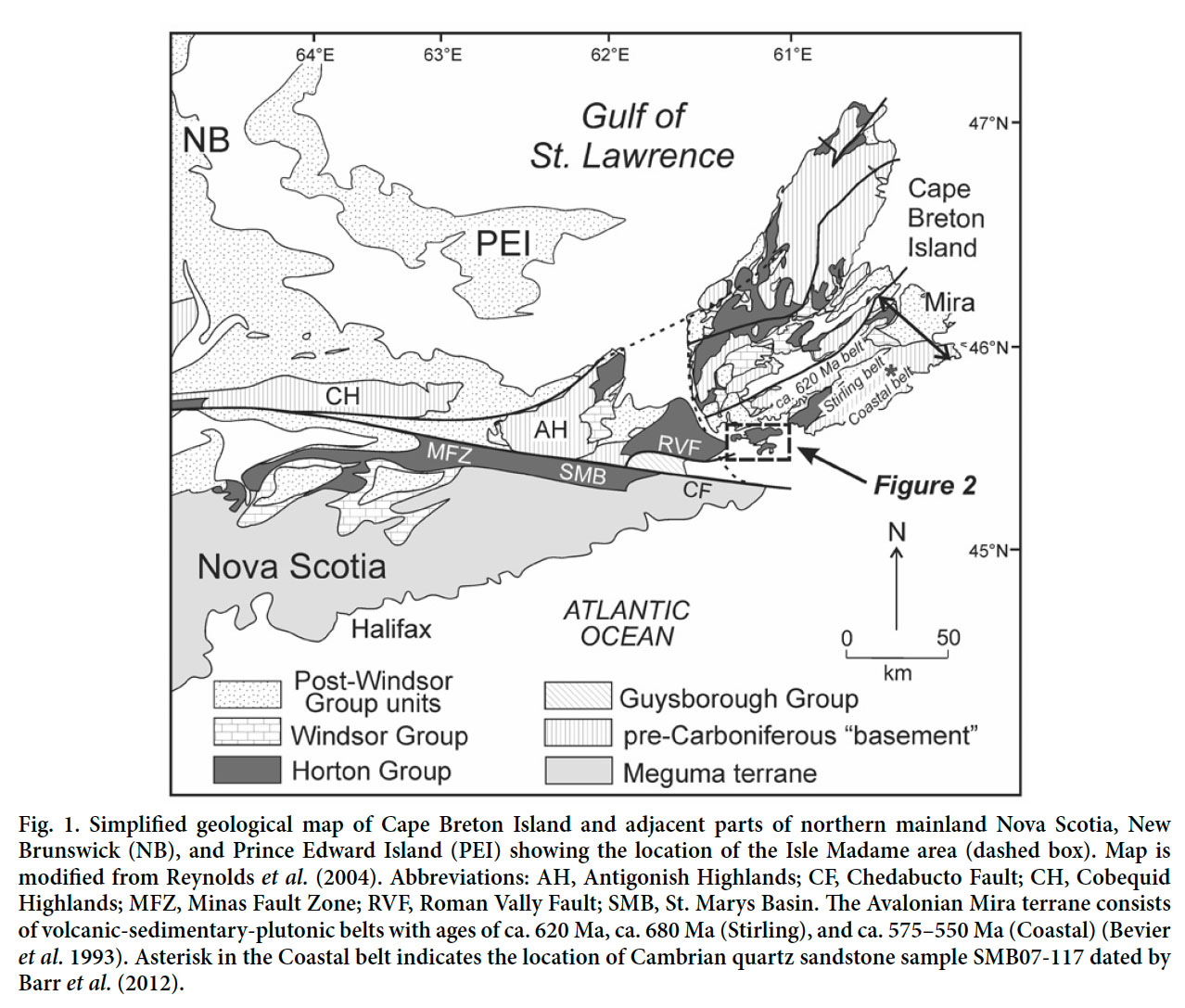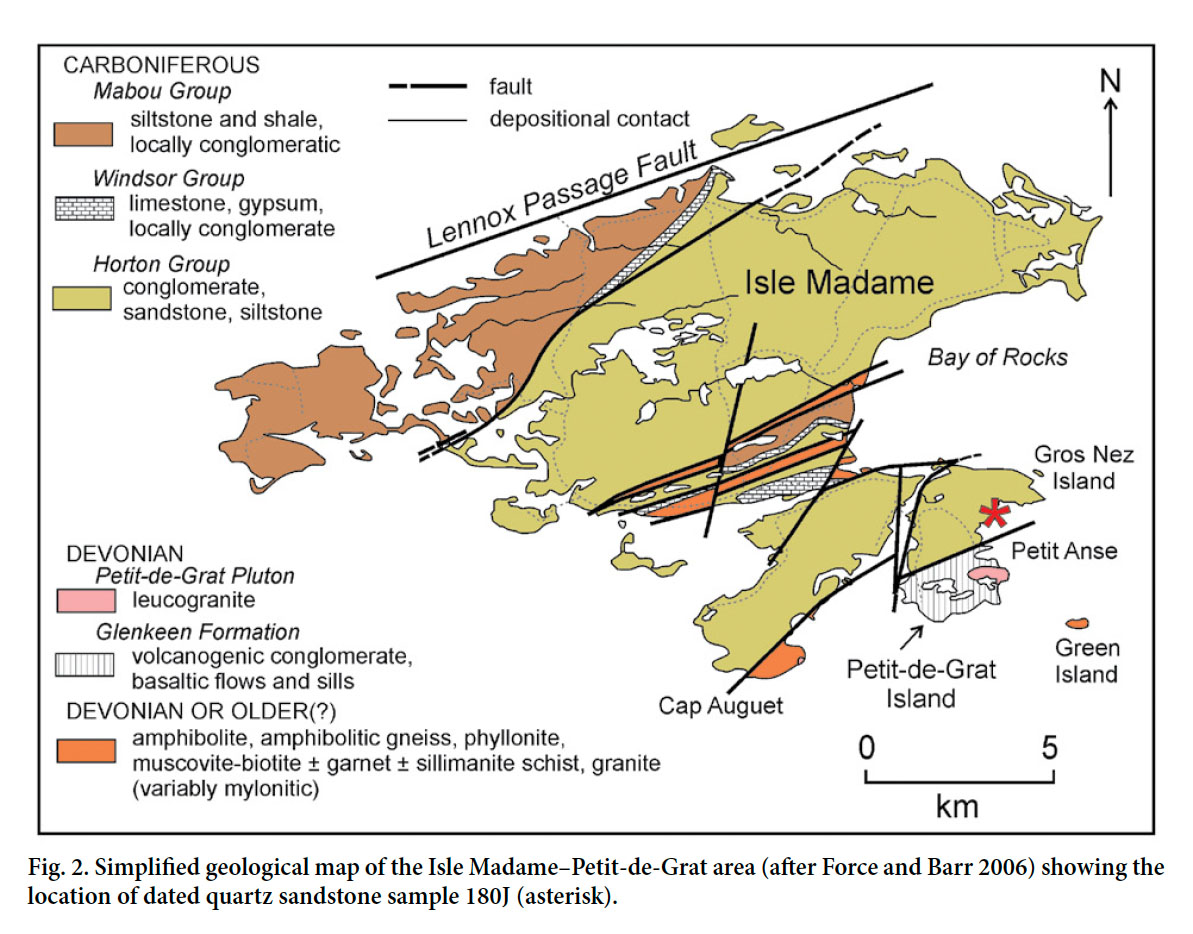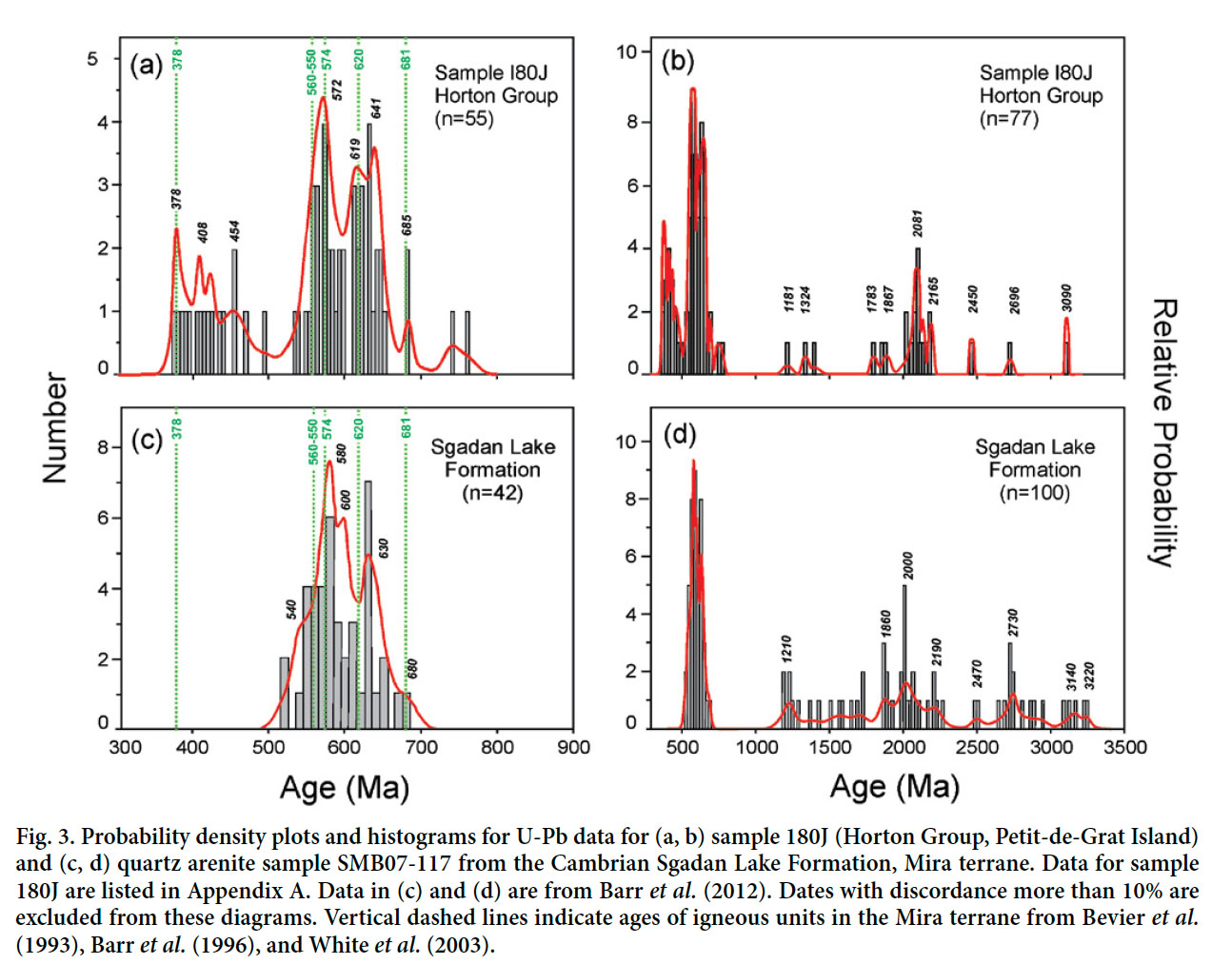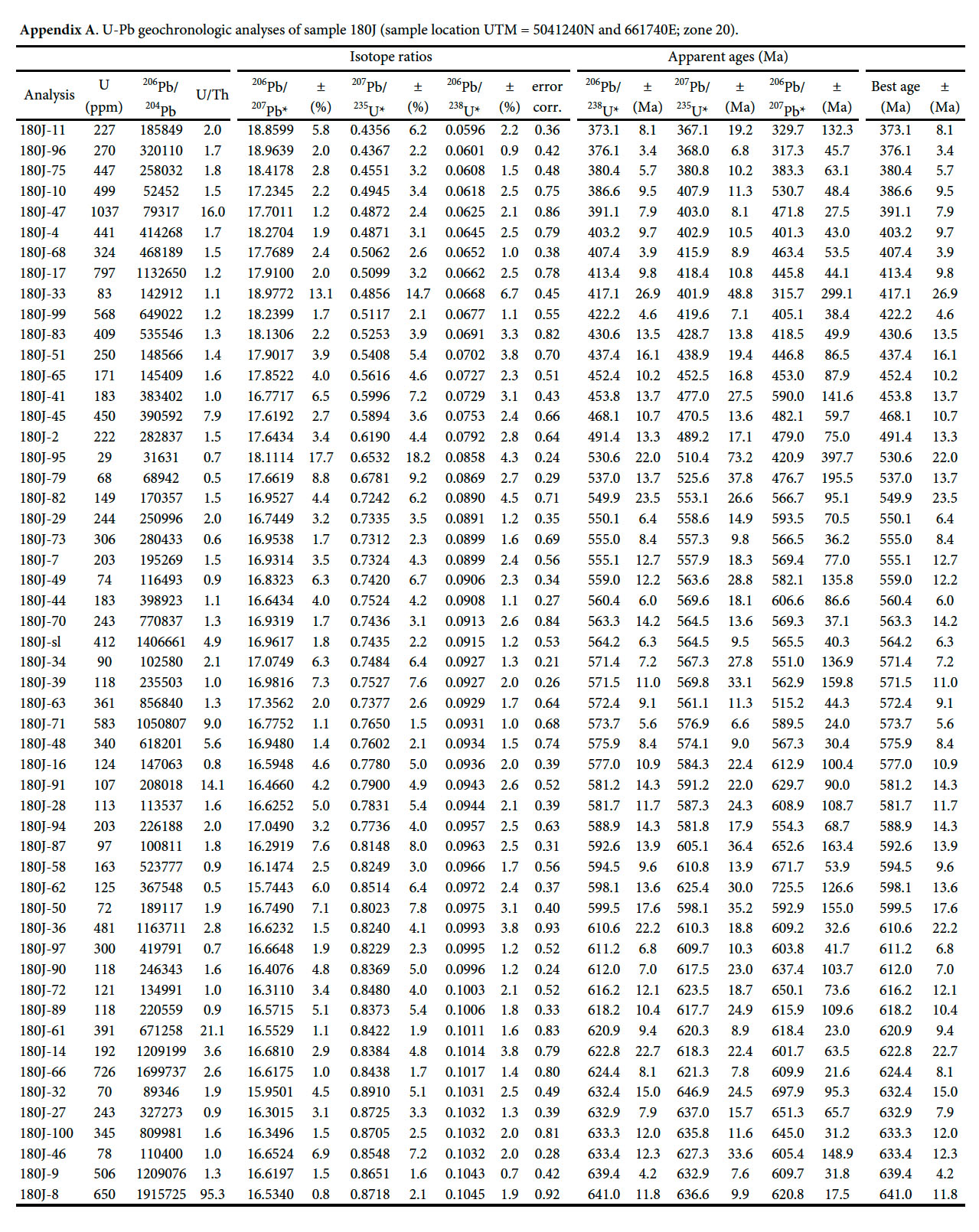Articles
Provenance of the Lower Carboniferous Horton Group, Petit-de-Grat Island, Nova Scotia, as revealed by detrital zircon ages
ABSTRACT
A quartz sandstone bed in a dominantly conglomeratic section in the central part of the Lower Carboniferous Horton Group on Petit-de-Grat Island, offshore southern Cape Breton Island, Nova Scotia, contains detrital zircon grains with ages ranging from mid-Devonian to Archean. The similarity of the Devonian and Neoproterozoic age spectrum to ages of igneous units in the adjacent Avalonian Mira terrane, in particular the Coastal belt, indicates that it was the main source area. This interpretation is supported by the similarity of the Neoproterozoic and older detrital zircon age spectrum to that of the detrital zircon age spectrum in a Cambrian sandstone unit from the Mira terrane. This interpretation indicates post-depositional dextral fault motion between the Isle Madame area and the Coastal belt.
RÉSUMÉ
Une couche de grès quartzeux repérée dans une section principalement conglomératique dans la partie centrale du groupe de Horton du Carbonifère inférieur sur l’île Petit-de-Grat, au sud de l’île du Cap-Breton, en Nouvelle-Écosse, contient des grains de zircon détritique dont l’âge va du Dévonien moyen à l’Archéen. La similitude du spectre d’âge du Dévonien et du Néoprotérozoïque avec celui des unités ignées trouvées dans le terrane Mira d’Avalon adjacent, en particulier la ceinture côtière, indique qu’il s’agit de la région source principale. Cette interprétation est étayée par la similitude du spectre d’âge du zircon détritique du Néoprotérozoïque et de périodes plus anciennes avec celui du zircon détritique trouvé dans une unité de grès du Cambrien provenant du terrane Mira. Cette interprétation indique un mouvement postsédimentaire d’une faille dextre entre la région de l’île Madame et la ceinture côtière.
[Traduit par la redaction]
INTRODUCTION
1 The Lower Carboniferous Horton Group on Isle Madame and adjacent Petit-de Grat Island off the southern tip of Cape Breton Island, Nova Scotia (Fig. 1) includes an abundance of steeply dipping, well-indurated polymictic conglomerate and interlayered finer grained clastic rocks with an estimated thickness of about 7 km (Force and Barr 2006; Giles et al. 2010). These rocks were described only briefly by Force and Barr (2006), who focused instead on structural aspects of the conglomerate-dominated units and their relation to older rocks in the area (Fig. 2). Clasts in the conglomerate range from granules to boulders, are generally subangular and poorly sorted, and consist mainly of varied volcanic and sedimentary clasts, with less abundant granitic and metamorphic clasts. Force and Barr (2006) interpreted the local environment of conglomerate deposition as a transtensional basin related to the Minas Fault Zone between southern and northern Nova Scotia (Fig. 1).
2 The provenance of sedimentary and volcanic clasts in the central part of the conglomeratic sequence is not clearly related to local basement sources, which are variably mylonitic metamorphic and plutonic rocks (Force and Barr 2006). The provenance of some of the sedimentary clasts was addressed by Boucot et al. (2006), who showed that Avalonia-related faunal assemblages are present in calcareous siltstone and sandstone clasts from both the lower part of the Horton Group and from younger conglomerate in the overlying Mabou Group. The faunal assemblages in these clasts imply derivation from the north, with material comparable to both Silurian rocks of the Antigonish Highlands and Cambrian units of southeastern Cape Breton Island. However, Boucot et al. (2006) further noted that the relatively large size of the clasts suggests local derivation from lower and middle Paleozoic units present under the Carboniferous units in the Isle Madame area but not presently exposed.
3 This paper presents ages of detrital zircon grains in a quartz arenite sample from an interbed in the conglomerate-dominated central part of the Horton Group sequence as a further step in investigating the source of the Horton Group sediments deposited in the Isle Madame area.
GEOLOGICAL SETTING
4 Deposits of Horton Group rocks occur throughout Cape Breton Island and mainland Nova Scotia (Fig. 1). Together with locally conformably and unconformably underlying Middle and Late Devonian sedimentary and bimodal volcanic rocks, these rocks form the earliest fill in the Maritimes Basin, mainly confined to grabens in older metamorphic and igneous basement rocks (e.g., Gibling et al. 2008; Pascucci et al. 2000). Overlying younger Carboniferous rocks progressively overlap the basement rocks, and include evaporite and carbonate rocks of the Windsor Group and overlying thick coal-bearing sequences (Fig. 1).
 Display large image of Figure 1
Display large image of Figure 15 Along the Minas Fault Zone on mainland Nova Scotia, rocks of the Horton Group overlap the boundary between the Meguma terrane of southern Nova Scotia and the Avalonian Antigonish and Cobequid Highlands of northern mainland Nova Scotia (Murphy et al. 2011). These rocks continue north of the Roman Valley Fault and into the Avalonian Mira terrane of southeastern Cape Breton Island (Fig. 1). The structural evolution of the Horton Group sequence on Isle Madame suggests that relative motion along these faults, all part of the Minas Fault Zone of Murphy et al. (2011), continued into the Carboniferous to form a transtensional basin in which the conglomerate units were deposited.
6 On Isle Madame the Horton Group is overlain, perhaps conformably, by Windsor Group rocks including both conglomerate and the more typical evaporite rocks (Giles et al. 2010). In contrast to the Horton Group conglomerate, except in its upper part, the Windsor Group conglomerate units are clearly derived from high-grade metamorphic and plutonic units exposed on Isle Madame (Force and Barr 2006). The base of the Horton Group on Isle Madame is an unconformity on rocks assigned to the Devonian Guysborough Group (White and Barr 1999), which has its type area (and more extensive exposure) on adjacent parts of the mainland Nova Scotia, between the Chedabucto and Roman Valley faults, both part of the Minas Fault Zone (Cormier et al. 1995; Webster et al. 1998; Murphy et al. 2011).
SAMPLE LOCATION
7 The best exposed and structurally simple section of Horton Group conglomerate in the Isle Madame area is along the northern and eastern shore of Petit-de-Grat Island, extending from Petit Anse toward Gros Nez Island (Fig. 2). This section lies unconformably on the Glenkeen Formation of the Guysborough Group and extends upward about 1300 m (true thickness) as a NNE-facing sequence dipping within a few degrees of vertical (White and Barr 1999; Force and Barr 2006). Non-conglomerate interbeds form embayments on the rugged coast, and many of these beds pinch out northwestward into conglomerate. This relationship suggests that sediment transport was to the southeast, in accord with clast imbrication in adjacent conglomerate units which show transport in the same direction. The depositional environment was probably in the distal part of an alluvial fan or fan-delta.
 Display large image of Figure 2
Display large image of Figure 28 Most of the finer beds intercalated with conglomerate are maroon or grey-green and range from sandy siltstone to grit, but a few are nearly white well-sorted quartz sandstone with a few dark heavy mineral-bearing laminae. The dating sample 180J, weighing approximately 2 kg, was collected from one of these beds at 740–755 m above the base of the section (UTM coordinates 5041240N and 661740E; grid zone 20). This bed, about 15 m thick, is best exposed at mid- or low tide, and its dark laminae show contortions that suggest a seismite origin (i.e., if so it still consisted of loose saturated sand when liquified by seismic activity).
9 Adjacent conglomerate beds contain cobbles and pebbles, commonly subangular. In approximate order of abundance the clasts include (1) intermediate to felsic volcanic rocks, generally quartz- and plagioclase-phyric, commonly tuffaceous, and weakly foliated, (2) sandstone and lesser siltstone, (3) mafic volcanic rocks, (4) felsic plutonic rocks, some deformed, and (5) the fault rocks of Force and Barr (2006).
METHODS AND RESULTS
10 Zircon crystals were extracted from quartz sandstone sample 180J at the LaserChron Lab, University of Arizona, by traditional methods of crushing and grinding, followed by separation with a Wilfley table, heavy liquids, and a Frantz magnetic separator. All zircon grains in the sample were retained in the final heavy mineral fraction. A large split of these grains was incorporated into a 1” epoxy mount together with fragments of a Sri Lankan standard zircon. The mount was sanded down to a depth of ~20 microns, polished, and cleaned prior to isotopic analysis. The sample showed a mixture of euhedral and rounded grains and grains from each type were analyzed. Zoning was obvious in a few grains, but no core and rim analyses were obtained from individual grains.
11 Zircon analyses were conducted by laser ablation-multicollector-inductively coupled plasma-mass spectrometry utilizing techniques described by Gehrels et al. (2006). Errors in determining 206Pb/238U result in a measurement error of 1–2% at the 2 sigma level for grains younger than about 0.8 Ga, and similar errors in 206Pb/204Pb for older grains. A standard with known age of 564 ±4 Ma (at the 2 sigma level) was used. All of the data are shown in Appendix A. The statistical program of Ludwig (2003) was used to produce relative age probability diagrams (Fig. 3a, b) for the 77 zircon grains that are less than 10% discordant. The majority of these ages (55 of 75) are between about 375 Ma and 760 Ma (Fig. 3a), whereas the remaining ages scatter back to the Archean, with a concentration at about 2000 Ma (Fig. 3b).
DISCUSSION
12 The majority of concordant ages from sample 180J are Neoproterozoic, with age peaks at 572 Ma, 619 Ma, and 640 Ma and a small peak at about 685 Ma (Fig. 3a). With the exception of the 640 Ma peak, these ages correspond well with ages reported from the Neoproterozoic igneous units which dominate the Mira terrane of Cape Breton Island (Bevier et al. 1993; Barr et al. 1996; White et al. 2003). In particular, a large component of ca. 572 Ma ages suggests that the Fourchu Group and related plutons in the coastal belt of the Mira terrane was a major contributor, consistent with the abundance of intermediate and felsic volcanic clasts in the conglomerate (Force and Barr 2006) as such rocks dominate in the Fourchu Group (Barr et al. 1996). A younger peak at 378 Ma corresponds with the age of Devonian granitoid plutons of the Mira terrane (e.g., Lower St. Esprit pluton with a U-Pb zircon age of 378+5/-1 Ma; Bevier et al. 1993). Older grains in the sample yielded a scatter of ages back to the Archean (3090 Ma), with a cluster between 2.0 and 2.2 Ga and a prominent peak at about 2081 Ma.
13 With the exception of the younger ages, the age spectrum from sample 180J is similar to that from a Cambrian quartz sandstone sample from the Mira terrane (Fig. 3c, d) reported by Barr et al. (2012). Notable similarities in the Mesoproterozic-Archean part of the spectrum include scattered ages at about 1200 Ma, a concentration of ages around 2000 Ma, and peaks at 2450–2470, ca. 2700, and 3100 Ma (Fig. 3d). Both samples show a dominance of Neoproterozoic ages, with major peaks at 572–580 and 620–640 Ma, and a small peak at about 680 Ma (Fig. 3c). This similarity in age distribution supports derivation of the central stratigraphic interval of conglomerate on Isle Madame and Petit-de-Grat Island mostly from Mira terrane sources.
14 Although the peak at 378 Ma matches the age of Devonian granitoid plutons in the Mira terrane as noted above, it is also similar to the ages of igneous components of the Guysborough Group, from which rhyolite yielded an age of 389 ± 2 Ma and gabbro an age of 385 ± 4 Ma (Cormier et al. 1995; Dunning et al. 2002). Clasts in the lowermost part of the Horton Group in the sampled section include mafic rocks and large angular clasts of arkosic sandstone which appear to be derived from the underlying Glenkeen Formation but those clasts do not persist into the central part of the section (E. R. Force, unpublished field observations). The ca. 378 Ma peak is also similar to the age of 373 ± 1 Ma reported for the nearby Petit-de-Grat granite (White et al. 2003) which intruded the Guysborough Group and which could have been exposed by the Early Carboniferous. However, clasts of this distinctive granite were not noted in the section.
 Display large image of Figure 3
Display large image of Figure 315 A source for the few zircon grains represented in sample 180J with Ordovician to Early Devonian ages is not known in the Mira terrane. Igneous rocks in the Antigonish Highlands are dominated by ages of ca. 620 Ma, 600 Ma, and 490–455 Ma (Hamilton and Murphy 2004; Murphy et al. 2012; Escarraga et al. 2012; Archibald et al. 2012) which are not prominent components of the spectrum of sample 180J and hence the Antigonish Highlands is not considered to have been a major source area.
16 The detrital zircon spectrum for sample 180J is similar to spectra in 3 samples from the Horton Group in the St. Marys Basin reported by Murphy and Hamilton (2000). All 3 St. Marys Basin samples, like sample 180J, show a prominent Paleoproterozoic peak at about 2100 Ma and a scattering of older peaks back into the Neoarchean. Although Murphy and Hamilton (2000) reported these peaks to indicate recycling of sediment from the Meguma terrane, more recent detrital zircon work (e.g., Barr et al. 2012) has shown that such ages are also characteristic in some samples from Avalonia, as exemplified by the sample from the Sgadan Lake Formation (Fig. 3d). As in sample 180J, Mesoproterozoic peaks are sparse in the St. Marys Basin samples, and a large Neoproterozoic peak is present at about 600 Ma. However, the size of the Neoproterozoic peak in the St. Marys Basin samples is more similar to the size of the Paleoproterozoic peak than in the case of sample 180J or the Sgadan Lake Formation sample, where the Neoproterozoic peak is proportionately larger than the Paleoproterozoic peak (Fig. 3b, d), a characteristic of samples higher in Meguma terrane stratigraphy (Krogh and Keppie 1990; Waldron et al. 2009).
17 Two of the three samples from the St. Marys Basin contain a few Paleozoic detrital grains with ages of ca. 453, 426, 411, 380, and 367 Ma, similar to the sparse Ordovician-Early Devonian ages obtained in sample 180J (Fig. 3a). Murphy and Hamilton (2000) suggested that the older three grains could have been derived from volcanic rocks in the Silurian-Devonian White Rock and New Canaan formations in the Meguma terrane or from the Dunn Point Formation. However, as noted above, the lack of representation of the dominant ages now known for igneous rocks in the Antigonish Highlands seems to make that area a less likely source. Murphy and Hamilton (2000) suggested that the 380 Ma and 367 Ma grains could have been derived from plutons in the Meguma terrane, but as also noted above, sources in the Guysborough Group or Devonian plutons in southeastern Cape Breton Island are also possible.
18 A source area dominated by the Fourchu Group and associated Devonian plutons of the Mira terrane requires those rocks to have been nearly adjacent, apparently to the northwest of the Isle Madame – Petit-de-Grat Island area in the Early Carboniferous. Force and Barr (2006) proposed that the “headwall” source of conglomerate in the Early Carboniferous transtensional basin is behind structures that are themselves splays of the Minas Fault Zone so the required assembly can be restored by placing southeastern Cape Breton Island on that headwall. Syn- to post-depositional dextral movement is required to move the Fourchu Group to its present position.
CONCLUSIONS
19 The similarity of the detrital zircon age spectrum in a quartz sandstone sample from the central part of the Horton Group on Petit-de-Grat Island to ages of Devonian and Neoproterozoic igneous units in the Mira terrane of southeastern Cape Breton Island suggests that those rocks provided much of the detritus in the group, including the abundant felsic volcanic clasts in the thick middle part of the conglomerate-dominated Horton Group sequence in the Isle Madame area. The Mesoproterozoic to Archean zircon population could have also have been derived from the same sources, as a Cambrian sandstone from the Mira terrane contains a similar Neoproterozoic and older detrital zircon population.
 Display large image of Table 1
Display large image of Table 1Eric Force thanks Ned Brown and all the staff of LaserChron Lab for their help with zircon analysis. Work by S. Barr in the Isle Madame area was funded by Natural Science and Engineering Council of Canada research grants. We thank journal reviewers Chris White and Brendan Murphy for their insightful comments which improved the content and clarity of the manuscript.
